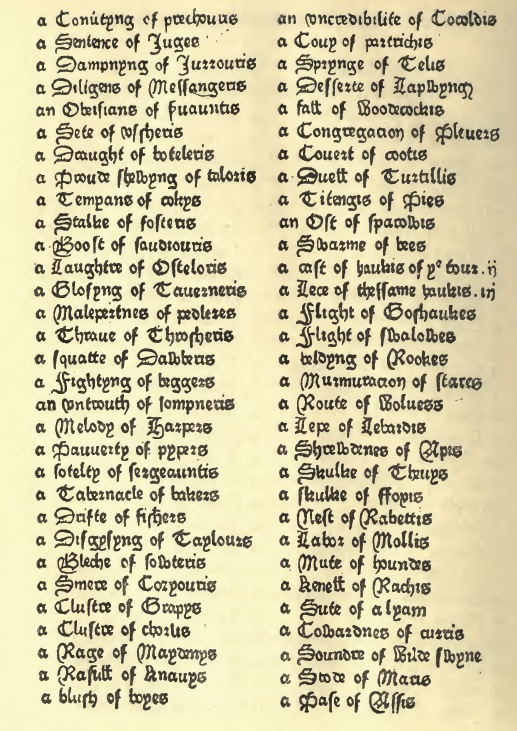One of our favorite pastimes at Sage is updating a series called Nature Video on the Twittertubes (see bottom of right hand column). The idea is to occasionally highlight a funny or awe-inspiring nature-related video. The last time we did this we had a tough call to make, as we ran across one awe-inspiring and one hilarious video, both involving out-of-nowhere groups of animals:
Murmuration from Sophie Windsor Clive on Vimeo.
In the end, we went with the starlings, partly because the name for the gathering of birds-—murmuration—-was so striking. Who knew? Not us, and the more we thought about it, the more we began to wonder: how did we end up calling a group of starlings a murmuration?
It turns out there’s a collective noun for just about any animal you can imagine. Many of the names go back to the 15th century, when, according to an Exaltation of Larks by James Lipton, British nobility was obsessed with hunting and the English language was going through an incredible period of growth. The first published list was included in the Book of St. Albans, one of the first books published on a printing press, and evidently so popular that “circulation for a long time vied with and perhaps exceeded that of every other contemporary production of the press of lesser eminence than Holy Writ.” The Book of St. Albans has three sections: one on hawking, one on hunting, and one on heraldry (that’s shields and such). The part on collective nouns is titled “The Companyes of Beastys and Fowlys”:

Some of the terms from the Book of St. Albans, such as “cete of badgers,” are now far from the common parlance. You’re also unlikely to hear any of the collective nouns the Book of St. Albans lays out for people–a drunkship of cobblers, an eloquence of lawyers, a superfluity of nuns. Yet plenty of the terms, from parliament of rooks to leap of leopards, are still out there, roaming the wilds of the language.
Of course, the Book of St. Albans is only part of the story. Plenty of collective nouns are more recent. A “coalition of cheetahs” seems to have its roots in the jargon of wildlife biologists. And it was only in 2000 that delegates to the IVth International Penguin Conference voted on official terms for a group of penguins: a “waddle” on land and a “raft” when in water. The Wikipedia page on the topic features an ongoing debate (“Nutcluster of dugongs?!? Is that for real?”) about the validity of certain terms. For someone looking to get a word in the dictionary, animal groups names seems to be a field where just making something up might still work.
The starling video became an internet hit, prompting some media outlets to revisit the science of murmurations. Perhaps the most surprising thing about this science is how fresh it is. According to Wired Magazine, researchers had to wait for fancy computer and video tools before they could explore murmurations, and once they did, in 2010, they found that the formations have more to do with cutting-edge physics than old-fashioned biology:
“[Murmurations] are best described with equations of “critical transitions” — systems that are poised to tip, to be almost instantly and completely transformed, like metals becoming magnetized or liquid turning to gas. Each starling in a flock is connected to every other. When a flock turns in unison, it’s a phase transition.”
And still, a big question remains. Researchers have yet to determine the mechanism that allows starlings hundreds of feet apart to make nearly instantaneous paired directional shifts; “How starlings achieve such a strong correlation remains a mystery to us.” In the meantime, even if we don’t quite understand how a group of starlings works, at least we have a word to describe it. Like a lot of animal group names, it’s not a word that’s strictly necessary. Also like a lot of animal group names, it’s a word whose existence seems almost as miraculous and brings almost as much pleasure as the thing it’s meant to describe. So if you’re ever so fortunate to see a group of starlings, don’t call it a flock. Seize the day! Murmur your admiration by saying “murmuration.”
And by the way, this is a maelstrom of salamanders:
